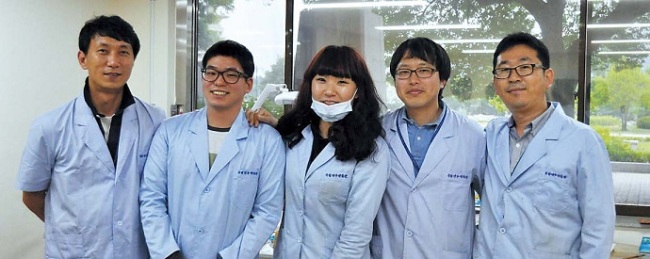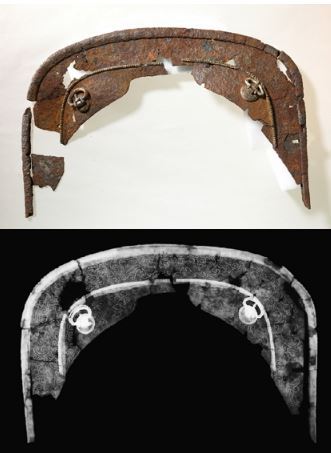Museum’s unsung heroes
Conservators bring ancient relics back to life with technology
By Korea HeraldPublished : May 19, 2014 - 20:13
GYEONGJU, North Gyeongsang Province ― Looking through a microscope, a researcher in a blue gown is poised to tackle a thumb-size, heavily corroded metal object with what appears to be a medical scalpel. After a deep breath, he starts scraping off the rust in a slow and controlled movement.
Welcome to the conservation lab of Gyeongju National Museum, where ancient treasures are reborn with the help of the latest technology.
“Patience is the greatest virtue around here,” says Shin Yong-bi, one of the three conservators at the museum. “If we hurry, the chance of ruining (these fragile relics) grows.”
Welcome to the conservation lab of Gyeongju National Museum, where ancient treasures are reborn with the help of the latest technology.
“Patience is the greatest virtue around here,” says Shin Yong-bi, one of the three conservators at the museum. “If we hurry, the chance of ruining (these fragile relics) grows.”

Conservators are a group of scientists who treat ancient relics for preservation and, in some cases, restore them as close to their original state as possible.
Shin specializes in the restoration of anything metal: gold regalia, bronze weaponry, iron farming tools, you name it.
Once relics are unearthed, they get a basic preservation treatment and are studied. Most of them, except for a few that look very significant, end up being stuck in museums’ storage rooms for decades, never given a chance to shine in exhibition halls.
That was the case, too, with a pair of saddle mudguards with a trace of gilt bronze ornaments found inside Cheonmachong, a royal tomb of the ancient kingdom of Silla.
When they were unearthed in 1973, they were in such poor condition that people thought it wasn’t possible to restore them. Left covered in mud, just like they were when found, to prevent them from rusting further, the mudguards had been kept in a storage room at the National Museum of Korea in Seoul for four decades.
In the spring of 2013, Gyeongju Museum decided to hold an exhibition of Cheonmachong-related relics, so the mudguards arrived at Shin’s lab for due treatment.


Shin and his team of researchers chose to focus on the side of the mudguards that was in better condition. A year of restoration work on the fragile relic has revealed a stunning painting of a flying horse on the gilt bronze.
“The excavation report (of Cheonmachong) describes the relic only briefly as ‘a saddle mudguard made of bamboo,’” Shin said. “There is no mention of the gilt bronze, let alone (of) a painting on it.”
The artifact is on display at the museum as one of the two highlights of the exhibition “Cheonmachong, the Royal Tomb of Silla.”
Also in the spotlight is another mudguard made of birch bark that sports a similar painting of a heavenly horse. One of Shin’s colleagues in charge of restoration of wooden relics restored the painting, which people didn’t know existed.
“Because it was so fragile, chemical treatment was not an option,” Shin said, recalling the restoration of the bamboo mudguard. “Every single touch had to be made with a microscope and precision tools like a surgical knife or an ultrasonic scaler.”
As one can imagine, it was a grindingly dull and stressful process.
“But it’s rewarding to see the items that we worked on displayed so nicely in the exhibition halls,” he said.
When Shin first joined the museum in 1999, people used the rule of thumb to conserve relics.
“We basically learned by doing. Now, there are universities with heritage conservation studies. But back then, relic conservation had no academic support in Korea,” he said.
As technologies advance, the look of the conservation lab changed greatly. For one, infrared or X-ray scans are now commonly used, Shin said.
“The X-ray has made a big difference in our work. What we long for now is 3-D equipment like CT (computerized tomography).”
The exhibition “Cheongmachong, the Royal Tombs of Silla” will run until June 22 at the Gyeongju National Museum in Gyeongju, North Gyeongsang Province. The mudguards with the heavenly horse drawn on them will be displayed from June 3 through June 22, for preservation reasons. The exhibit will move to Cheongju National Museum from July 24 until Oct. 5, but it is not known yet whether the mudguards will be part of it.
For details about the ongoing exhibition, visit gyeongju.museum.go.kr or call (054) 740-7500.
By Lee Sun-young (milaya@heraldcorp.com)
-
Articles by Korea Herald







![[Hello India] Hyundai Motor vows to boost 'clean mobility' in India](http://res.heraldm.com/phpwas/restmb_idxmake.php?idx=644&simg=/content/image/2024/04/25/20240425050672_0.jpg&u=)











